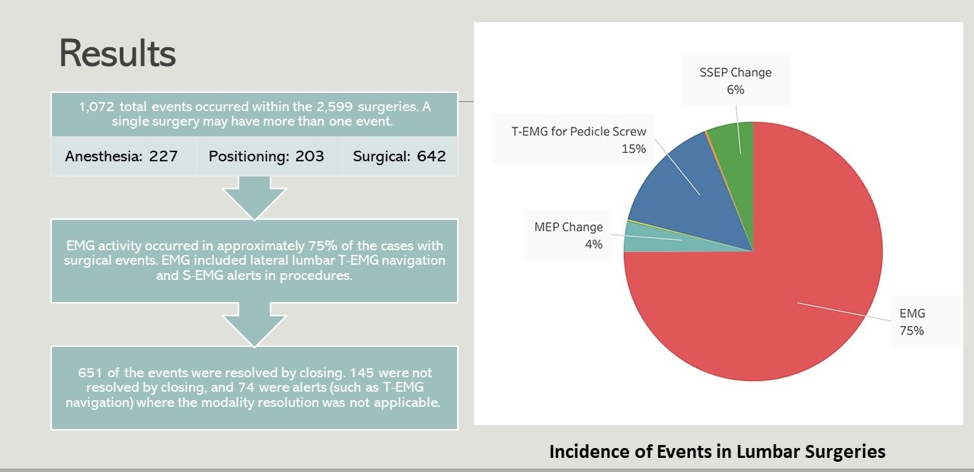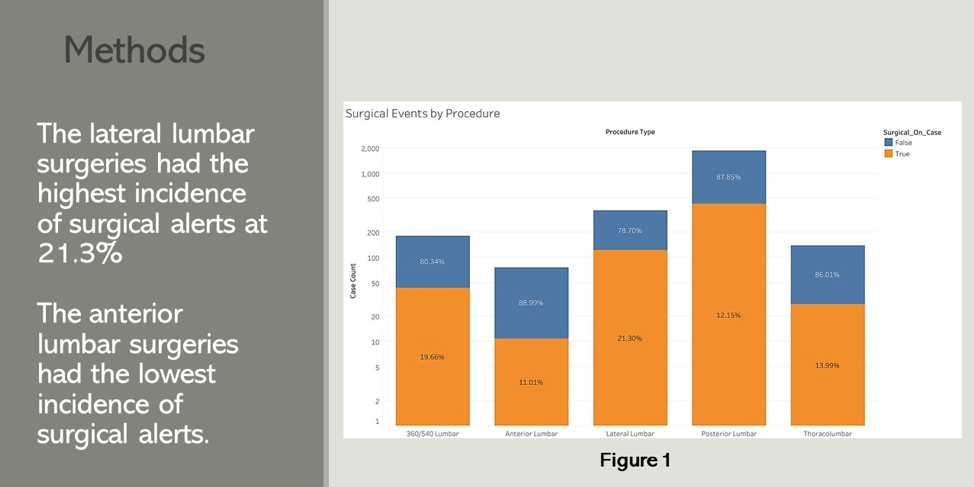Our Axis Research Team Presented A New Study
By Admin | August 19, 2021
Faisal R. Jahangiri, MD, CNIM, D.ABNM, FASNM, FASET 1, 2 Kathryn Overzet 1,2 , Hiral Gorasia 2 , Haley Puryear 2 , Tal Allouche 2 , Elizabeth Ekvall 2 , John Moorman 2 , Nicholas Bathurst 2
1 Axis Neuromonitoring Richardson, Texas; 2 School of Behavioral and Brain Sciences, The University of Texas at Dallas, Richardson, Texas;
Abstract
Introduction:
IONM or Intraoperative Neurophysiological Monitoring has been used in surgical procedures where the functional integrity of the nervous system is at risk. More recent studies have shown the benefits of IONM in lumbar surgeries. Our data shows the incidence of different alerts in various types of lumbar surgeries utilizing IONM.
Methods:
We performed a retrospective analysis of IONM data of 2,599 extradural lumbar surgeries performed between January 2019 to March 2021 (1304-50.2% males and 1295-49.8% females; ages 6-89 years, median 52 years). We identified events caused by:
o Surgical factors, and
o non-surgical factors
• anesthesia
• positioning
• technical
• interpreting physician, and
• internet
The Pearson correlation analysis was performed using SPSS 27. Within the category of surgical events, we further classified them by the modality in which they occurred. Surgical events were categorized by changes in neurophysiological signals that required intraoperative intervention, a surgical pause, or other efforts to prevent any
neurological injury. The study aimed to determine the following:
o Most common alert type; anesthetic/physiological, positioning, or surgical
o Type of surgical approach with the highest incidence of alerts
o Modality with the highest incidence of alerts

Results:
One thousand seventy-two (1,072) total events occurred within the 2,599 surgeries. Therefore,
a single surgery may have more than one event.
o Anesthesia: 227
o Positioning: 203
o Surgical: 642
EMG activity occurred in approximately 75% of the cases with surgical events. EMG included lateral lumbar T-EMG navigation and S-EMG alerts in procedures. Six hundred fifty-one (651) of the events were resolved by the end of the surgery. One hundred forty-five (145) were not resolved by closing, and 74 were alerts (such as T-EMG navigation) where the modality resolution was not applicable. The lateral lumbar surgeries had the highest incidence of surgical alerts at 21.3%. The anterior lumbar surgeries had the lowest incidence of surgical alerts at 11.01%.

Conclusion:
• According to our data, surgical events were the most common type of alerts.
• The most common modality with alerts was EMG, which shows that EMG's surgical events were the primary occurrence within lumbar procedures in this data.
• All surgeries were performed with a CNIM certified technologist with a remote online neurophysiology board-certified neurologist.
• Further research is required to determine whether anesthesia, technical experience, and patient history will impact an event's likelihood during a lumbar surgery.
• Outcome comparison between IONM and non-IONM patients and a method of grading the relevance of specific events detected by IONM would advance our understanding of how these events relate to the prevalence of post-operative deficits.
• IONM assists the surgical team in preventing post-operative neurological deficits. Many potential post-operative neurological deficits were able to be resolved intraoperatively with IONM.
Presented at:
American Society of Neurophysiological Monitoring (ASNM) 2021 Virtual Annual Meeting, May
21-23, 2021 (E-Poster).
Biography
Dr. Faisal R. Jahangiri is the Vice President of Clinical Affairs at Axis Neuromonitoring LLC in Richardson, Texas. He is also immediate past president of the American Society of Neurophysiological Monitoring (ASNM). Dr. Jahangiri specializes in the field of Intra Operative Neurophysiological Monitoring (IONM). He is faculty at The University of Texas at Dallas (Texas) and Labouré College of Healthcare (Massachusetts). He is one of the few board-certified diplomates by the American Board of Neurophysiological Monitoring (ABNM). He has published 37 papers, 100 plusconference research presentations, chapters, and three reference books on IONM. Dr. Jahangiri is frequently invited to speak at national and international meetings. He is also a Fellow of ASNM and ASET. Dr. Jahangiri is leading the education, research, quality assurance, and clinical teams at Axis neuromonitoring.



